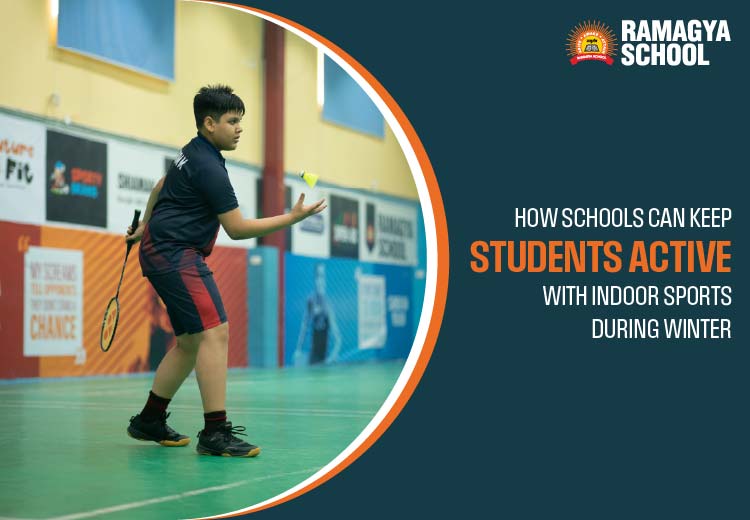When winter comes, the weather gets colder, outdoor playtime becomes shorter and kids tend to stay inside for a longer time. Schools face the challenge to keep children moving, energetic, and active. One solution is to use indoor sports activities to help kids be in good health, active and joyful even when the outdoor space gets too cold and wet.
Indoor sports for kids are not just a back-up plan. They are fun, meaningful and beneficial to children’s physical and mental well-being. By creating good activities and using creative facilities by schools they can turn winter into a period filled with joy and movement.
Why Indoor Sports Are Important During Winter
When the weather is too cold, rainy, or it gets dark early, children naturally play less. However, this means more sitting and time on screens with less physical activity. This is why indoor sports activities are essential as they keep kids physically active, assist them to improve coordination and teamwork and boost overall wellbeing.
Indoor sports for kids let them use your energy and enthusiasm in a secure and comfortable setting. They also assist in building relationships, promote healthy lifestyles, and help reduce the anxiety that is often associated with spending too much time indoors.
Which Indoor Sports Activities Work Well for Schools?
Here are some innovative and simple suggestions for schools to use:
- Table Tennis & Indoor Badminton: Both are great for enhancing the hand eye coordination, agility, and quick thinking. They are both classic examples of indoor sports activities.
- Obstacle Courses Indoors: Use mats, cones, ropes and chairs to build an enjoyable course. This is an ideal part of the indoor sports for kids that let kids run through the course, dodge obstacles, and have fun.
- Yoga or Stretching Sessions: There is no need for every movement to be fast. Gentle activities help improve flexibility, focus and peace. A good combination of yoga and sports activities can create an ideal balance.
- Games Adapted for Indoors: For example, balloon volleyball or foam ball football or mini-basketball. They keep the excitement and energy flowing inside. You can also let them play board games like chess, carrom and ludo. This would enhance their mental strength.
- Team Relays or Group Challenges: Divide the classes into teams and let them take part in indoor sports activities which are safe and competitive, like jumping races, stepping stones or tag games inside the huge halls.
- Dance & Movement Stations: Modern PE classes include rhythm and music. If we add indoor activities for kids and teens, they can enjoy movement in many different forms and not just traditional sports gear.
How Schools Can Organize Indoor Sports Smartly
Here are some key steps schools should follow:

- Clear a Safe Space
Check that the hall or gym is free of hazards like no wet floor, no wires dangling and furniture pushed aside. This keeps playing secure and enjoyable. - Plan a Weekly Routine
Plan two or three hours every week that are dedicated to indoor games. Regularity in practice helps kids maintain their fitness and develop great life skills instead of playing only occasionally. - Mix Fun and Fitness
Combine energetic games (like relays, or even obstacle courses) with low energy ones (like Yoga or stretching). This ensures that all students can participate completely. - Use Simple Equipment
Not all games need fancy equipment. Cones, foam balls, yoga mats, ribbons all are effective. The focus is on interaction and movement and not on the use of equipment. - Encourage Participation & Teamwork
Make sure that the sessions are open to all children, regardless of whether they are active or not, they can join in. This can also build the confidence of children who are introverts and shy. - Track and Celebrate Progress
Schools could keep a simple chart or display in which students’ participation and growth in indoor sports are recognized. This helps build pride and motivate students.
Benefits of Using Indoor Sports for Kids in Schools
When schools use indoor sports activities, the benefits multiply:
- Students burn energy and stay less restless.
- Physical fitness remains constant even when outdoor activities are limited.
- Children develop social skills as they learn to play, collaborate and encourage each other.
- The improvement in mental health because moving your body while dancing or playing any sport produces endorphins and decreases stress.
- Teachers and staff observe children are more calm, focused and eager to learn.
Tips for Making Indoor Sports Fun and Safe
- Always begin by warming up and then cool down. A few minutes of stretching will help prevent stiff muscles.
- Use bright colours, music and themes to create an exciting experience.
- Change the games around so that they do not get repetitive, for e.g., Monday: obstacle course, Wednesday: relay team, on Friday: yoga & dance
- Let students pick their own game sometimes. This will increase their interest and buy-in.
- Be sure that restrooms and hydration breaks are scheduled as winter can trick us into ignoring thirst.
Conclusion
The cold winter months don’t mean that students are sluggish and unengaged. With smart planning, schools can offer indoor sports activities that are fun, healthy and exciting. By offering indoor activities for kids twice or thrice per week, schools allow students to retain their energy, improve fitness and stay ready to learn. Your body’s energy and stamina should not fall even when the weather gets cold. Let the sports field and gym be filled with laughter, fun games, and teamwork all winter long.
FAQs
Q1. How long should indoor sports sessions be in winter?
30-45 minutes is usually enough. It keeps kids active without tiring them too much.
Q2. Do we need a big hall or special equipment for indoor games?
No. Many indoor games only need a clean space and simple things like cones, mats, or soft balls and for board games you would need the games related to them.
Q3. Does indoor play replace outdoor play?
No. Indoor play is just a good option for cold days. When the weather is better, outdoor play should continue.
Q4. Are indoor sports enough for fitness?
They help a lot, especially in winter. But when possible, outdoor time, fresh air, and sunlight are also important.




